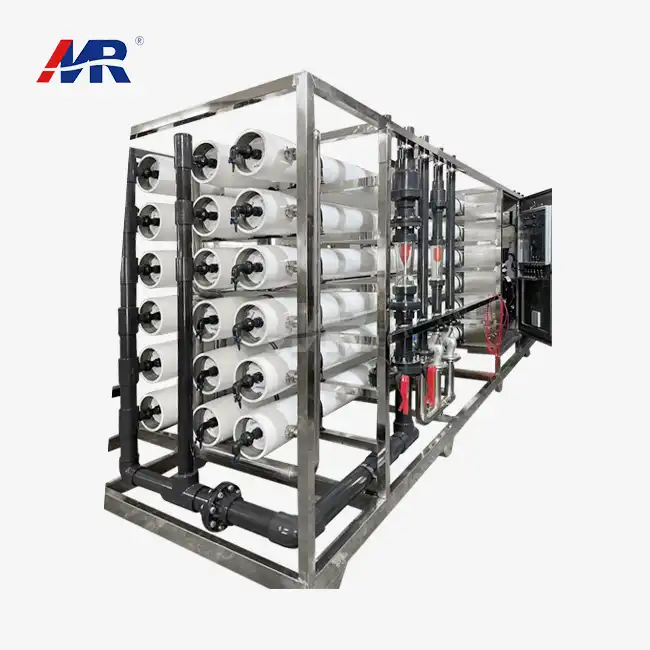The science behind contaminant rejection in RO systems
Reverse osmosis systems effectively remove contaminants due to the unique structure of their membranes, which are designed to filter out even the tiniest particles. These membranes are typically made from thin-film composite materials, containing pores so small they can block contaminants as small as individual ions. The rejection of these contaminants is based on several key principles:
Size exclusion is the primary method of contaminant removal. The membrane's pores are small enough to physically block larger particles, such as suspended solids and microorganisms, preventing them from passing through the system.
Charge repulsion plays a significant role as well. Many RO membranes carry a negative charge, which repels similarly charged contaminants like dissolved salts and minerals. This electrostatic interaction further enhances the filtration process, improving the membrane's ability to reject contaminants.
Lastly, diffusion control affects the efficiency of the system. Water molecules, being smaller and more mobile, pass through the membrane more easily than larger molecules or contaminants. This difference in diffusion rates enables RO systems to selectively allow water to pass while blocking contaminants.
Together, these mechanisms ensure that reverse osmosis systems are highly effective at purifying water by removing a wide range of contaminants.
How do BWRO plants compare to standard RO for contaminant removal?
BWRO plants, or Brackish Water Reverse Osmosis plants, are specialized reverse osmosis systems designed to treat water with moderate salinity levels. While both standard RO and BWRO plants utilize similar principles, there are some key differences in their contaminant removal capabilities:
Salinity tolerance
BWRO plants are optimized to handle water with higher dissolved solid concentrations compared to standard RO systems. This makes them particularly effective for treating brackish groundwater or surface water sources with elevated salinity levels.
Energy efficiency
Due to the lower salinity of feed water, BWRO plants typically operate at lower pressures than seawater RO systems. This translates to reduced energy consumption and operational costs while maintaining high contaminant removal rates.
Membrane configuration
BWRO plants often employ specialized membrane configurations and materials tailored to brackish water treatment. These adaptations can enhance contaminant removal efficiency and membrane longevity in challenging water conditions.
Reverse osmosis system filtration: dissolved solids vs. microorganisms
While reverse osmosis systems are highly effective at removing a broad spectrum of contaminants, their performance can vary depending on the type of impurity. Understanding the differences in filtration efficiency for dissolved solids and microorganisms is crucial for optimizing RO system design and operation.
Dissolved solids removal
RO membranes excel at removing dissolved solids from water. These include:
- Inorganic ions (e.g., sodium, chloride, calcium, magnesium)
- Heavy metals (e.g., lead, arsenic, mercury)
- Dissolved organic compounds
The rejection rate for dissolved solids in a well-designed RO system can exceed 99%, making it an ideal choice for applications requiring high-purity water, such as in the pharmaceutical or semiconductor industries.
Microorganism filtration
RO membranes are also highly effective at removing microorganisms, including:
- Bacteria
- Viruses
- Protozoa
The pore size of RO membranes is typically smaller than the size of most microorganisms, ensuring their physical removal from the water stream. However, it's important to note that RO systems are not designed as a primary disinfection method, and additional treatment steps may be necessary to ensure complete microbial control.
Synergistic filtration
The combination of dissolved solids and microorganism removal in RO systems creates a synergistic effect. By eliminating dissolved nutrients and organic compounds, RO filtration also reduces the potential for microbial growth in the treated water, further enhancing its quality and stability.
In conclusion, reverse osmosis technology offers a powerful and versatile solution for contaminant removal in water treatment applications. From standard RO systems to specialized reverse osmosis plant, this technology continues to evolve, meeting the diverse needs of industries ranging from municipal water treatment to high-purity industrial processes.
Are you looking for a reliable and efficient reverse osmosis solution for your water treatment needs? Guangdong Morui Environmental Technology Co., Ltd. specializes in cutting-edge water treatment technologies, including industrial wastewater treatment, domestic sewage treatment, seawater desalination, and drinking water production. Our expert team provides comprehensive services, from equipment supply to installation, commissioning, and after-sales support.
With our state-of-the-art membrane production facility and equipment processing factories, we offer customized solutions tailored to your specific requirements. Whether you need a compact RO system or a large-scale BWRO plant, our products deliver superior performance and reliability. Don't let water quality issues hold your business back. Contact us today at benson@guangdongmorui.com to discover how our advanced reverse osmosis solutions can transform your water treatment processes.
References
1. Greenlee, L.F., et al. (2009). Reverse osmosis desalination: Water sources, technology, and today's challenges. Water Research, 43(9), 2317-2348.
2. Fritzmann, C., et al. (2007). State-of-the-art of reverse osmosis desalination. Desalination, 216(1-3), 1-76.
3. Lee, K.P., et al. (2011). A review of reverse osmosis membrane materials for desalination—Development to date and future potential. Journal of Membrane Science, 370(1-2), 1-22.
4. Malaeb, L., & Ayoub, G.M. (2011). Reverse osmosis technology for water treatment: State of the art review. Desalination, 267(1), 1-8.
5. Qasim, M., et al. (2019). Reverse osmosis desalination: A state-of-the-art review. Desalination, 459, 59-104.
6. Shahid, M.K., & Choi, Y.G. (2018). The comparative study for scale inhibition on surface of RO membranes in wastewater reclamation: CO2 purging versus three different antiscalants. Journal of Membrane Science, 546, 61-69.

_1745823981883.webp)


